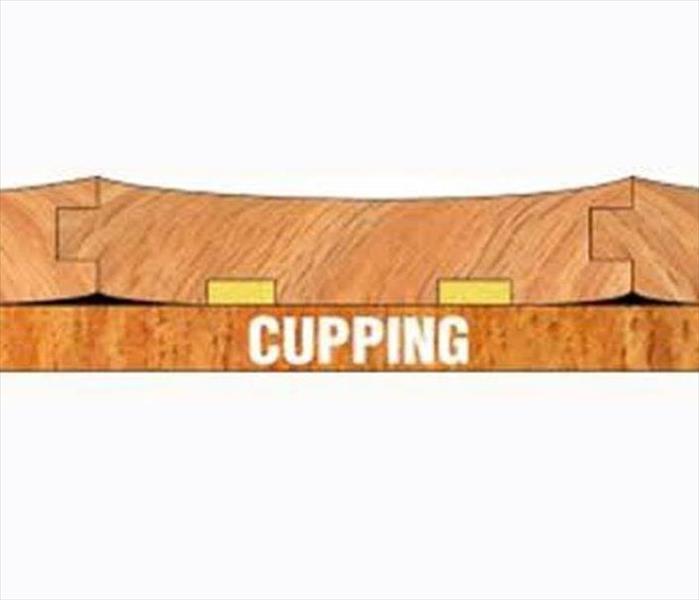Cupping, Peaking, and Buckling Wood Floors in Your Home or Business
4/4/2022 (Permalink)
Cupping can happen in your home or business as a result of an increased moisture content that saturates the bottom of the boards.
Wood Damage from Water, Age, or Installation
Having wooden floors or engineered hardwood flooring can be a challenge even when things are going well. It is strongly advised that people who want this type of flooring have a professional install them. Wooden floors and engineered hardwood flooring can develop issues that may alter the appearance and shape of the wood. There are more things to be concerned with in addition to water damage when caring for wood floors and engineered hardwood flooring. The most common problems are buckling, peaking, and cupping.
Moisture Damage
Even if someone's floors experience moisture damage, there won't be any need to replace the entire floor. Buckling, crowing, and cupping are used to describe the warping as well as damage experienced by engineered hardwood flooring and wood floors. These conditions are caused by changes in humidity, groundwater, moisture, and more.
Humidity And Moisture
People want wood floors and engineered hardwood flooring because of the improved appearance they provide in any space where they are placed. They are also known for being sensitive and delicate. Warping and disfigurement can occur from humidity and moisture. It may be possible to control the humidity of a home. Moisture can still become an issue even if a home has no problems with flooding or leaking pipes.
Relative Humidity
The air in any space inside an enclosed area will have humidity. There will always be water vapor in the air unless it measures zero. Over time, the wood in a home such as the doors, walls, and floors will adjust to the humidity levels. It will reach equilibrium. This is why it is common to hear a house settle. The floorboards will creak when experiencing weather that disturbs the equilibrium. When a home experiences extreme changes in moisture, it will cause the floorboards to warp.
Buckling
This can happen when floorboards aren't given the opportunity to adjust to the climate in a home. This will occur when a person notices floorboards pulling away from the sub-floor. The floorboards bow inward. They may also come right off of the floor. This could also be the result of poor installation. The newly installed wood has to have room to contract and expand and adjust to changing humidity levels and temperatures. If the floorboards don't have enough space, they will buckle.
Peaking
This is an expansion issue. The main reason this happens is problems with the installation. Wooden floors are regularly contracting and expanding based on the humidity level in a home. The weather and temperature also play a role. This should be a consideration during the installation process. It is important for there to be the proper space between each floorboard as well as space between the flooring and the walls. If this isn't done, the wood won't be able to properly expand. There won't be any room for the wood swelling. This will result in peaking.
Cupping
This occurs when excessive moisture impacts the underside of floorboards. The surface of the boards will seem to be cupping and have a concave shape. The side of the boards will be higher than the middle of the boards. They will bow inward. Engineered hardwood flooring and wood floors can experience cupping. This is different from other types of damage because of the location of the moisture damage. The bottom of the boards becomes saturated with moisture. This situation can occur over a few days. The reason for it is probably underlying water damage. This could be part of a serious problem like leakage and groundwater. It is something to be resolved by a professional plumber. It is also possible for boards to cup because of too much water vapor in the air. The boards will then warp much slower. This is a challenge to detect since there will be no immediate changes.
Repairing Common Issues
When it comes to cupping, it is possible to repair it by sanding the floor. This will make the boards even. Before sanding the floor, it needs to have enough time for the moisture content to return to normal. Should this not be done, it can cause peaking. When the boards are bent upward, sanding shouldn't be done. It is possible to spot treat places that buckle or peak. The boards that have been affected can be removed and given time to dry and then replaced.
People don't have any real control over unexpected moisture issues. Damage can result from unexpected flooding as well as leaking pipes. It's also not possible to do anything about the moisture or humidity in the air. The floorboards of wooden floors or engineered hardwood flooring can be protected by covering them with a sealant product. It is also recommended to have a dehumidifier running in rooms where hardwood floors or engineered hardwood flooring is located. This will take out the dampness or high humidity that is present.






 24/7 Emergency Service
24/7 Emergency Service